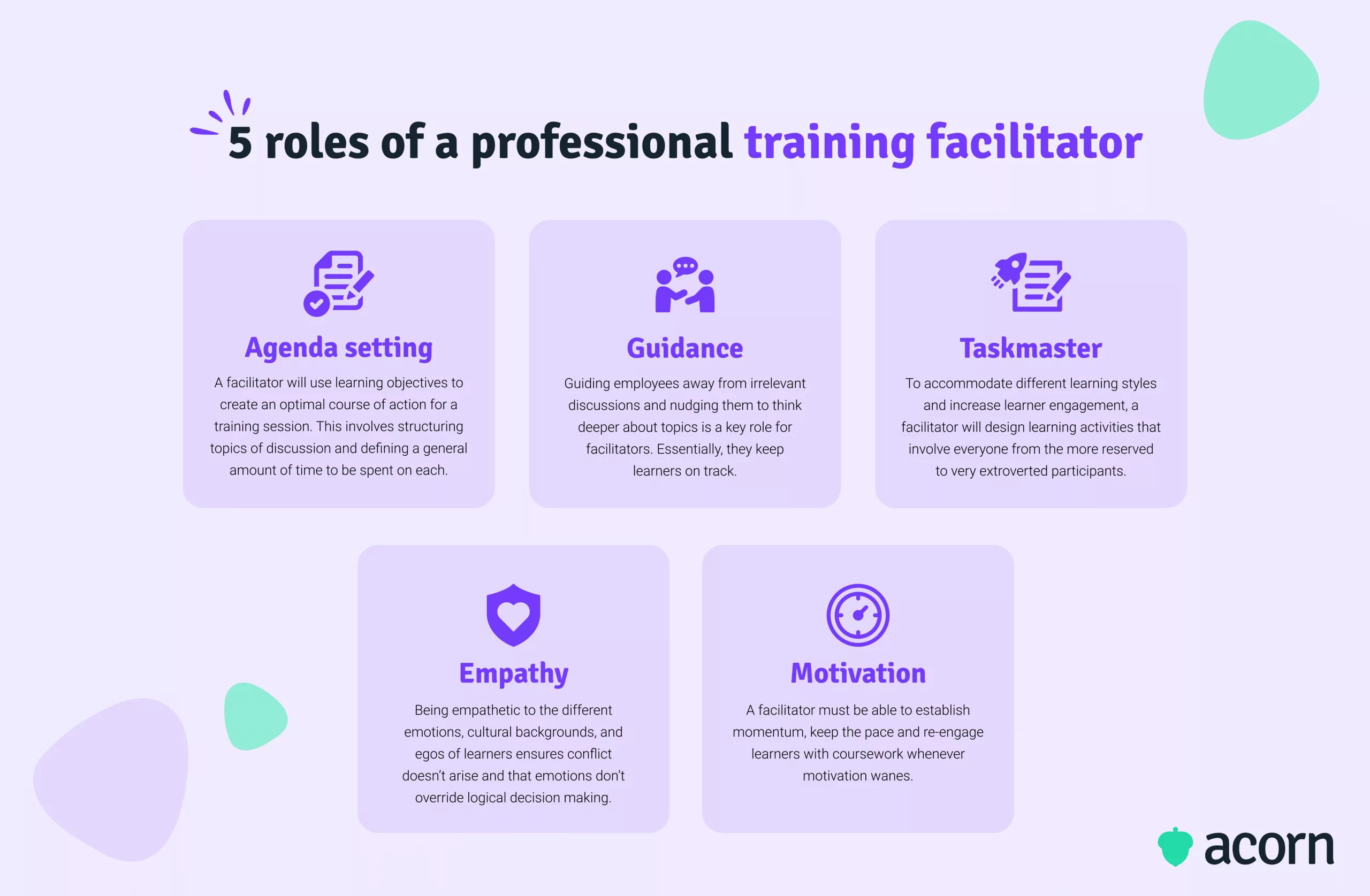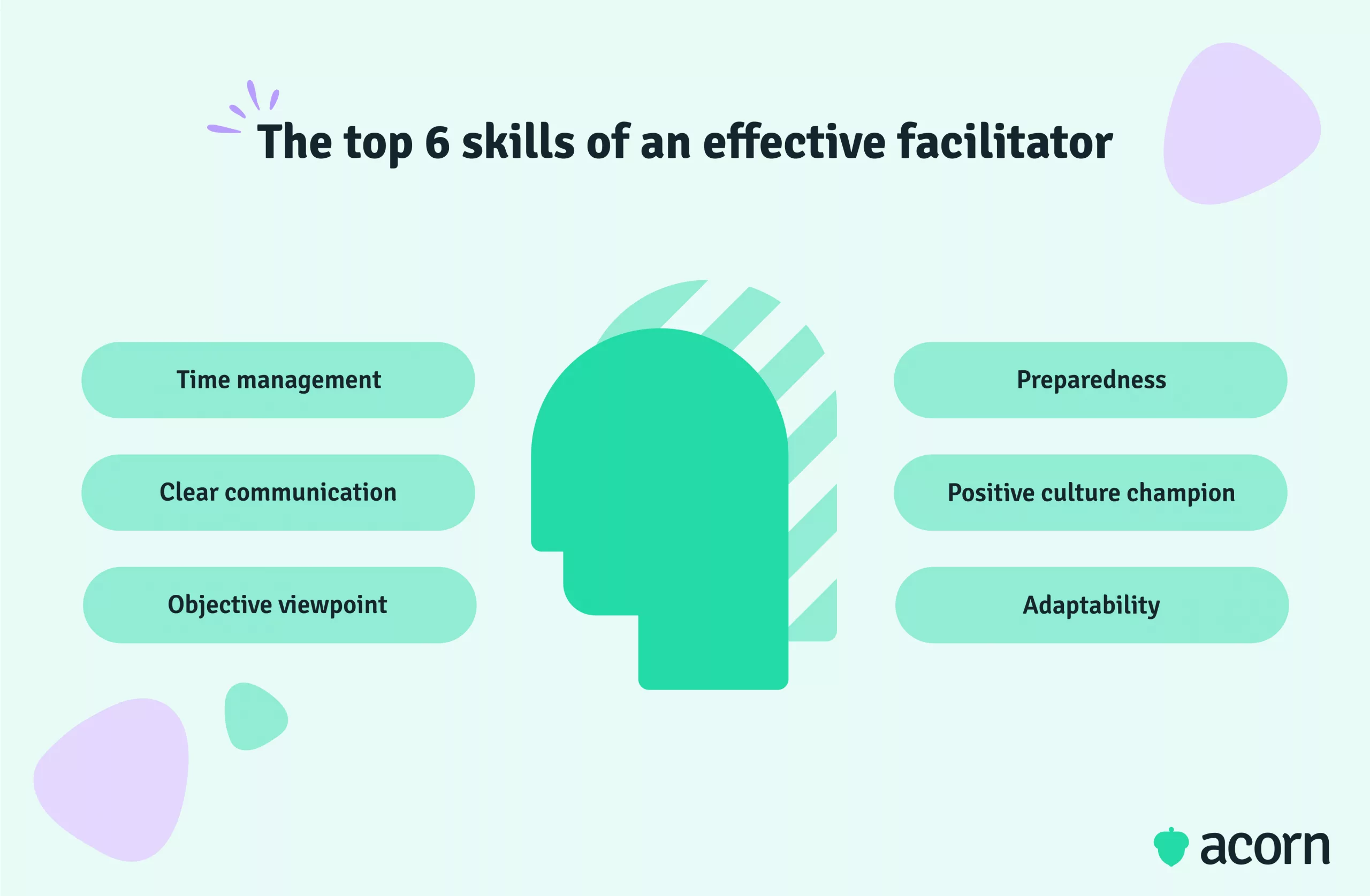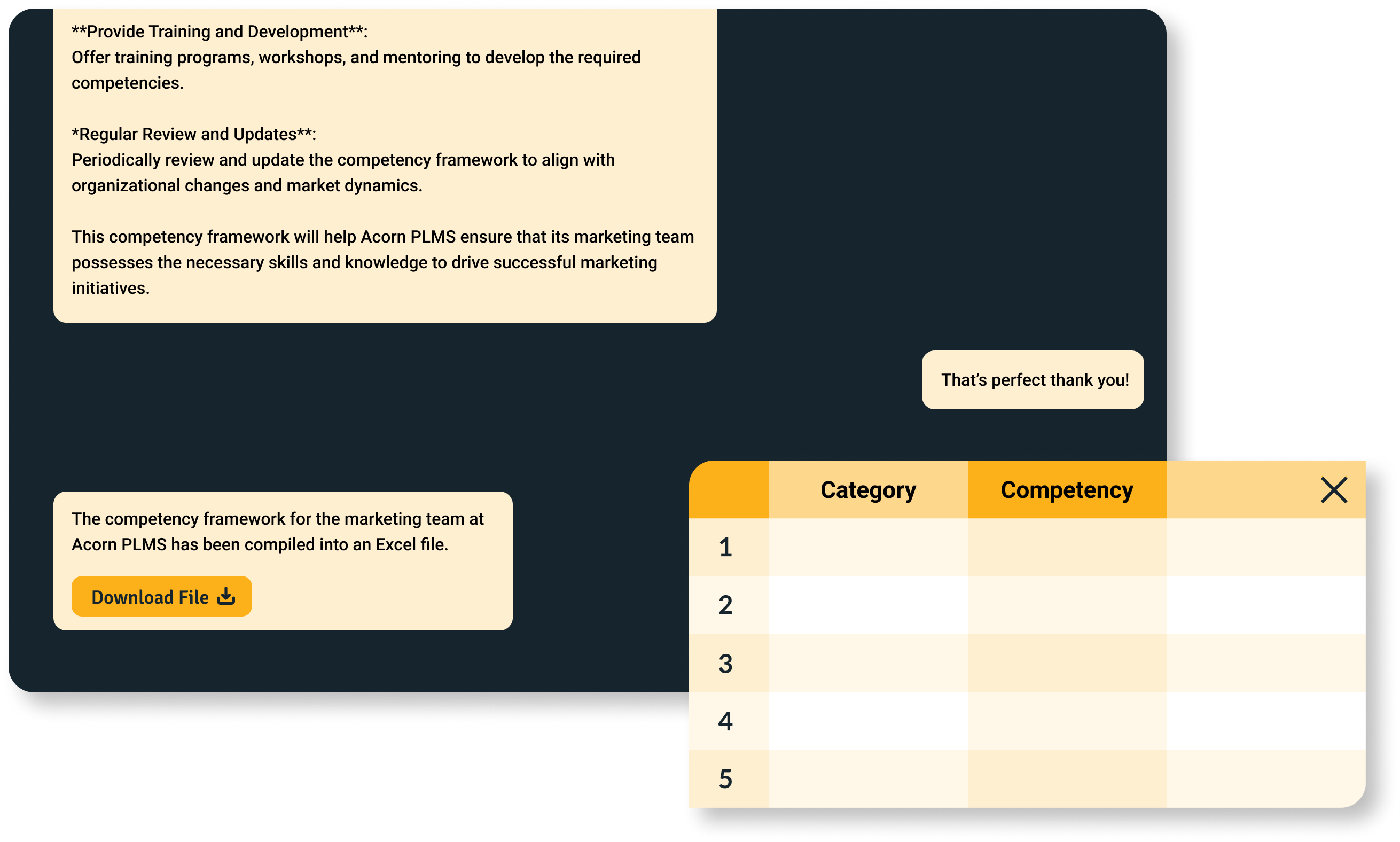The Skills to Look for in Training Facilitators
Reading Time:

Lead the pack with the latest in strategic L&D every month— straight to your inbox.
SubscribeCompared to the teacher-student relationship of instructor-led training, facilitators guide your employees to solve problems and learn lessons themselves.
Effectively engaging learners means enabling them to discover, contextualize, and apply new information.
Facilitators are those guides on the side who foster discussion, lead activities and encourage learners to dive a little deeper into topics. It’s an important role to play in face-to-face and online learning, as well as individual and group learning environments.
In this article, we’ll discuss what a training facilitator does, the roles they’ll have to assume to facilitate deeper learning, their function in business, and the skills high-performing facilitators possess.
What is a training facilitator?
Training facilitators support the development and process of training programs to help learners more effectively retain and apply new skills. The role involves overseeing and optimising training methods within an organisation. Within training, a facilitator guides learners towards achieving learning outcomes by asking specific questions, fostering discussion and encouraging self-directed inquiry.
What are the roles of a professional facilitator?
Facilitators are process experts. They’re not an instructor or lecturer, who are content or subject matter experts. There’ll be some crossover but for the most part, training facilitators are more focused on optimising training processes—leading insightful discussions, fostering knowledge sharing and helping people learn from the experience itself.
During a training session, a facilitator will:
- Propose or make suggestions
- Utilise different learning techniques
- Create break out groups
- Support and encourage participation
- Foster self-discovery
- Handle disruptive behaviour
- Mitigate conflict
- Help learners uncover alternative lines of thinking and solutions.
That’s a few different hats to wear. The main roles of a facilitator, however, include agenda setting, guidance, task management, motivating learners, and managing the emotional culture of the group.
Agenda setting
Understanding the purpose and learning outcomes of the training session or program is key to facilitating a smooth process. A facilitator will think about:
- The goals of the session and how those align with business needs
- The topics that need to be addressed to promote those goals. What skills are being enhanced? What knowledge is being imparted?
These may be made available for the group before a training session. Skilled facilitators will ensure objectives are clearly stated for learners’ benefit, and the purpose of each agenda item defined with a dedicated amount of time. Alternative courses of action will also be considered in the agenda.
Guidance
Though agendas set the structure, a facilitator is only there to guide the process—which means it is possible for participants to go off track. It’s easy to head on a stimulating and interesting tangent (particularly in a close-knit group) that is not related to the matter at hand. Guidance involves ending irrelevant discussions, preventing detours and nudging people towards thinking in greater detail. A professional facilitator, as an example, will park discussions for later dates if they’re not immediately pertinent and keep track of timing to respect everyone’s schedules.
Taskmaster
Different people have different learning styles, and a good facilitator will account for this. This means different activities will be incorporated into the session like group work and discussions. Some people will be more introverted than others or may even be rolled over by bigger personalities. Involving them by asking questions or seeking their opinion will help bring all participants into discussions and ensure everyone is engaging equally. This is key: Facilitators favour asking questions over providing answers, and they’re not afraid to ask the “dumb” questions if it means directing people towards the right learning outcomes.
Empathy
It’s important to be tuned into how group members are acting or reacting. This could be stress, aggravation, alienation or even someone becoming a little drunk with power. It’s not just about playing peacemaker, but rather making sure emotions don’t get the better of a group. It’s also important to be sensitive to the different cultures and backgrounds in the group, which may impact how content is interpreted.
Motivation
Motivations can wane, for reasons from participants being uninterested in a particular task to the program being intensive or a group not interacting as much as needed. Losing momentum isn’t usually a time-viable option for training related to strategic workforce activities, which is why being able to understand the different motivators for each participant is an important skill. Not every person will be motivated by one rousing speech, so the best facilitators can adapt to an individual’s mindset rather than assuming how a group of people will interact.
And what good facilitators don’t do…
A skilled facilitator knows that they are there to create a smoother learning process, not to impart knowledge in the way a teacher would. This means a facilitator does not:
- Act as the technical or content expert
- Impose their opinions on the material
- Own the learners’ thoughts and outcomes
- Actively train learners or present the content.
These are all immersive actions. A professional facilitator will only intervene when learners are getting off track or if they appear stuck. In any case, the intent is to nudge learners in the right direction, rather than tell them what outcomes they need to arrive at.

The importance of training facilitators in business
Crafting a culture of lifelong learning is important to ensuring an organisation’s success. However, there are a number of hurdles that can hinder the learning process, from siloed learning software to nonstandard training processes.
Some of the constraints for effective, self-directed training are:
- Multi-generational challenges. Broadly speaking, an employee at 50 in a senior position may have different learning goals and concerns, if any at all, to a junior employee in their 20s. Hurdles to effectively engaging different generations in learning include their approaches to teamwork vs autonomy, sense of company loyalty and view of organisational hierarchy.
- Conflict can be healthy when it encourages us to think outside our own biases, especially in workplace training that is designed to develop new ideas and behaviours. However, unchecked confrontations within group work can arise without objective intervention. Groupthink (flawed decision-making to preserve the status quo) is often a nasty side effect of conflict.
- Time constraints and other commitments that limit an individual’s ability to invest in training. This in particular isn’t always an easy factor to control.
- Bounded rationality is the idea that when people find a complex idea hard to fully grasp, they are incapable of being rational about or seeking an alternative solution to their problem than the one they have already decided is the best. This stems from believing we know all there is to know about a topic, stopping us from being open to learning. Employees who believe their knowledge is concrete may be resistant to fully engaging with training programs.
How facilitators drive effective workplace learning
There is research to suggest people respect and recognise the intent of explicit coordination. In other words, people recognise the intent of someone who moderates, summarises and clarifies group discussions and actions.
Providing employees high-quality learning resources isn’t always sufficient to help them get the most from the online learning experience, particularly if they are working and studying remotely. A social presence such as a professional facilitator is the foundation of constructive collaboration, since they ensure that the learning objectives are achieved in the most optimal way to not waste human or financial resources.
Facilitators know to align learning objectives with business goals
Admittedly, there are ways to link employee training to business goals without a facilitator. If you’re using a learning management system (LMS), creating learning pathways helps you ensure employees are upskilling as needed. However, if time gets away from them, or they aren’t responsive to certain required courses, it can be hard to remind them of the importance of said training.
Facilitators know how to quantify the impact one has on the other in a way that learners may not be. And to that end, they can monitor the training process in such a way to maximise the investments of both learners (expectations and time) and organisations (money and resources). As part of their agenda setting, a skilled facilitator will know to talk to key personnel and ascertain the skillsets that are to be developed.
For example, facilitators can outline how tasks connect to various job sets by asking questions that guide learners to think laterally, or creating activities in which knowledge is applied to real life conundrums. This helps to mitigate vague or misinterpreted expectations, ill-timed feedback, and counterproductive pathways of discovery.
A key factor here is reflecting on individual development and collective performance indicators, reinforcing the need for personal and group progress amongst learners. High-performing facilitators strive for intentional inclusion. They know when to question unspoken rules of the group and when to engage in dialectical inquiry. This gets group members debating topics, leaning into division of thought that they may have otherwise avoided productively discussing.
Facilitators know how to push learners out of their comfort zones
No one can know everything, but we can’t be certain employees will actively seek learning opportunities. Some employees may mistake content that challenges their viewpoint or critical thinking skills, for content that is simply too challenging to complete.
Accepting failure is an important soft skill for employees. Failure can stem from uncertainty about or complexity of the work at hand; that can be a combination of needs and problems that people have not faced before, according to the Harvard Business Review. Facilitators play a key role in helping employees discern the intelligent failures (as in, those that can be learned from) from preventable.
When you have a diversified customer/client base, you need to have different sociocultural dynamics represented in learning. Pushing people to think beyond their own biases is important for creating a future-proofed workforce. Skilled facilitators know it’s not about applying pressure, but asking questions to enhance concentration and focus on the right content. This develops crucial self-reflective behaviours in your employees, which contributes to their application of skills and likelihood to validate their knowledge with peers in the workplace.
The top 6 skills of an effective facilitator
In order for facilitators to easily move between different roles, they’ll need to possess a certain skillset. It’s rooted in their ability to be emotionally intelligent, respectful and weigh individual needs against desired business outcomes.
An effective facilitator:
- Stays neutral
- Is prepared
- Clearly communicates
- Builds a positive team culture
- Manages time well
- Is adaptable.

Objectivity
Skilled facilitators remove themselves from the outcome learners achieve. It’s not about proving their intelligence to the team or showcasing that they know the solution, but guiding them through the process. It’s also not necessarily about staying neutral, because facilitators do have an agenda. The ability to see things objectively means you can change your perspective, stay composed and make more informed decisions that capture the essence of the problem at hand. Put simply, an effective facilitator aims to bring out the best in others.
Objectivity means that facilitators are empathetic, think before they speak, are self-aware, inquisitive, seek facts over opinions and are humble if their interpretation isn’t correct. In saying that, a high-performing facilitator won’t keel over in the name of fairness; they retain their beliefs and opinions, but detach from pride and respect that other’s may be more informed.
Preparedness
At a high level, facilitation involves ideation, analysis and consensus building. Facilitators have to be well versed in the problem at hand and the people involved in making a decision.
On the former note, being able to guide a group of people through a process depends on a structure and general idea of desired outcome. Facilitators research—through surveys, feedback, discussions with key people—to outline an agenda and key touchpoints for the group. They’re also aware that they need to flexible, and plan for alternate directions that suit a group’s needs. And on the latter, knowing who’s in the room is key to bringing together many people who may not have worked together before. It can be as simple as factoring time to get to know one another to add value to the group dynamic.

Define the skills, knowledge & behaviors your facilitators need in minutes with our Capability Assistant.
BUILD YOUR FRAMEWORKClear communication
Understanding one another is how we achieve impactful work, and it’s a key part of social learning. Keeping everyone on the same page, clearly dictating goals and instructions, and managing conflict are key communication skills a good training facilitator should have.
Active listening
Correctly interpreting body language and demonstrating interest through eye contact and receptive discourse is key to making all members feel included. Active listeners take nonverbal cues as much as tone into their interpretation, and reflect back what a speaker has said to ensure that the message has been understood correctly. Knowing what and why someone is saying something is crucial to creating an inviting learning environment.
Psychological safety
Creating a safe space for others to communicate is just as important as being a good communicator. An effective facilitator makes certain that each learner feels safe to challenge ideas, admit mistakes and ask questions—because they know that when people feel safe to be heard, they’re more likely to participate. This is done not only by setting the ground rules, but encouraging active participation.
Building a positive culture
In a group learning environment, a good facilitator finds the common thread between learners, particularly those who work in different departments or hold different positions. Finding themes in thoughts and a shared interest helps to create a more inclusive learning culture. It’s not about getting everyone thinking the same—rather, facilitators find areas for individuals to connect so it becomes an us-vs-the-problem over an every-man-for-himself situation. At its heart, facilitation is about creating a better experience for people to work together.
Time management
Whatever the activity, there’ll be a time limit on it. Managing other people within a time constraint is much harder than managing your own, which is what defines a high performing facilitator. They’re able to plan out how long different stages should take against the total amount of time learners have to reach an outcome. This includes asking the right questions, monitoring tasks and individual progress to gauge knowledge retention, adjusting agendas to spend more or less time on tasks as need be.
Adaptability
Agendas are made in good faith, but learners might require a different tact than what is planned. In that case, being able to switch up is key to being an effective facilitator. That may mean responding to hostile moods, changing approaches when a line of enquiry isn’t working, re-energising the group, or even remaining unfazed by external factors. Adaptability is a key skill for business success, too, because it leads to better self-evaluation and critical thinking skills—and it’s a skill that’s often learned experientially (say, from facilitator to learner).
Key takeaways
Effective facilitation is the secret to a successful future of work. Facilitators can work across remote and dynamic workplaces, making workplace training more meaningful and engaging for your employees.
Being a skill facilitator involves being able to fluidly switch between the following roles:
- Agenda setter
- Group guide
- Empath
- Task master
- Motivator
- Mentor
- Minute taker.
A facilitator needs to be able to plan agendas, energise lagging inspiration, read and respect emotions, guide people onto the right path, provide advice and insight when needed, and keep track of how individuals and groups retain knowledge. And in order to be what learners need when it’s needed, high-performing facilitators need to possess skills such as:
- Objectivity
- Clear communication
- Adaptability
- Time management
- Preparedness
- Culture cultivating.
Facilitators aim to substantially increase the effectiveness of learning in order to more efficiently achieve business goals. It’s an important business function that is rooted in creating a workforce of diverse talent and skills, as well as one that can innovate and learn from failure. Group training, for one, can be a complex and conflictive scenario, particularly when it’s for high-value business outcomes. Structured facilitator-led workshops help you sidestep the growing pains of varying opinions and priorities, making facilitators the key to developing a healthy and collaborative learning culture.